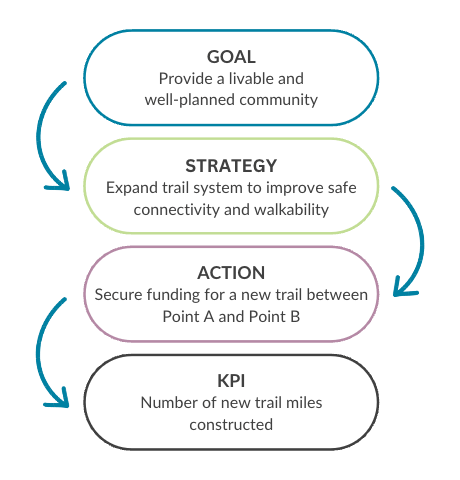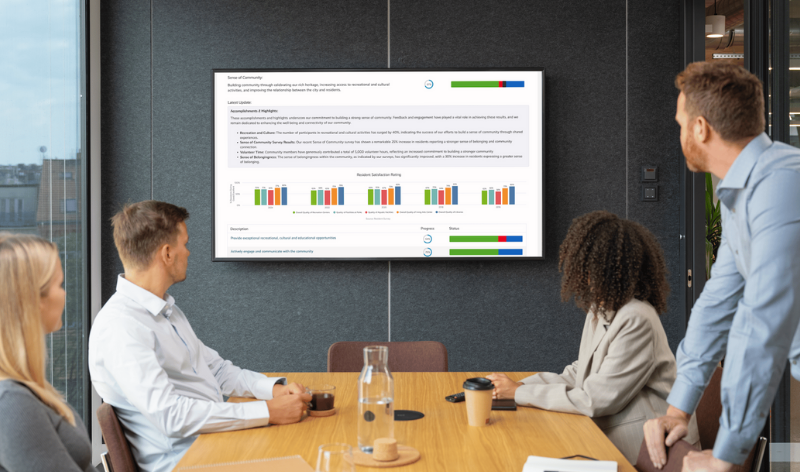Contents
As a local government leader or inspired public sector official, you’ve got ideas–big ones. And in a professional setting, big ideas often end up as grand, overarching organizational strategies or initiatives… we love those! But identifying your strategic priorities, and aligning your leadership and key stakeholders behind them, is just the beginning.
Next, you’ll need to develop and set SMART goals and relevant KPIs to help you move from strategy to action.
Why set SMART KPIs and goals?
Setting your organizational strategies in place is like finding north on your compass–you now know which direction you want to head in, but you still have to get to rowing and steering the ship! That’s where getting SMART with your goal setting, and using a well-defined “family of measures” system for developing relevant, smart KPIs, can help you get from where you are to where you’d like to be. We’ll spend more time on the “family of measures” approach later!
Getting SMART with your goal setting can also make it easier to sell organizational change to your team—regardless of whether you’re a city manager with over 200 team members, a superintendent in charge of a district that covers more than 100 schools, or a Fortune 500 company. When you know exactly what you’re working toward, and have a feasible action plan in place to reach your goal, it instills confidence and a sense of purpose in your teammates and the stakeholders.
Put simply, SMART goals, actions, and KPIs have a much higher likelihood of being achieved!
Let’s break down the SMART system and really determine how you can make it work for you.
If you’ve already got a strategic plan, great! Pull it out and compare all your strategies, objectives, goals, actions, tasks, priorities, KPIs—or whatever planning terminology your organization uses—and layer it on top of what you’re about to read here to ensure you’re moving in the right strategic direction, and that you’ll know when you get there.
How to develop SMART goals
For today’s exercise, we’re going to start with defining SMART goals and actions before moving on to key performance indicators (KPIs)–after all, you’ll most likely be using the latter to measure how well you’re doing on the former.
So, let’s start by getting SMART from the top!
SMART goal setting and action planning is an essential element of strategic success. You may have heard the SMART mnemonic device before. Below, we’ll detail what each one of the letters stands for, and provide a little context for how we plan to use this acronym to add specificity, accountability, and transparency to your goal setting.
SMART stands for:
SPECIFIC: Something that can be actioned and is well-defined.
MEASURABLE: An goal or action that can have an outcome or performance measure(s) associated with it.
ATTAINABLE: Goals and actions have to be achievable. Make sure there is enough time, the right people, and the appropriate budget assigned to each, and that any major roadblocks have been considered.
RELEVANT: The goal or action needs to align with a strategic priority. (Note, this can also mean “Resourced”—ensuring that your goal has what it needs to be accomplished!)
TIMEBOUND: Your activity should have start and end dates.
By making sure that your goals are SMART, you can eliminate the ambiguity that plagues so many ineffective organizations and strategic plans. SMART goals define a clear path from point A to point B. Everyone knows where you’re starting, where you hope to finish, and how you plan to get there.
Ultimately, the SMART planning approach enhances the efficiency and effectiveness of our public institutions by providing a systematic and results-oriented framework for identifying the direction you want to move, and allowing you to develop performance measures that speak to your progress in that direction.
Speaking of which…
How to build and set SMART KPIs
KPIs, or key performance indicators, are metrics that you define and track in order to measure performance. These data points correlate with progress made towards a desired outcome or result. Sometimes we call them other names, like key outcome indicators, but in the end they are all working towards the same thing–providing you with an ability to measure your current performance against your idealized one.
But what should you measure, and how should you measure it? That’s a great question, and one we encounter a lot at Envisio!
For developing KPIs that work for you and your public sector organization, we recommend a strategic framework known as the Family of Measures (FoM) approach. It provides a structured way to identify what you should be measuring, and helps you align those measures with the SMART goals and big-picture strategies we spoke of above. It also helps you classify any data you might already be collecting, and place it in the appropriate bucket for measuring performance.
Here’s how you use the four cornerstones of the FoM approach–inputs, outputs, outcomes, and efficiencies–to catalog your existing and future data:
Inputs
Inputs are the resources, such as employee hours, budget, technology, or other assets, that are required to carry out your goals and subsequently, your strategies. These are pretty easy to find, calculate, and manage. Identifying your inputs helps you better manage your resources and be more efficient when you dole them out.
Public Sector KPI Examples:
- Staff
- Budget
- Technologies required
Outputs
Your outputs represent the tangible and immediate results of your programs, activities, and efforts. These are the key products, services, and deliverables that your public sector organization provides to stakeholders. By analyzing the relationship between your inputs and your outputs, you can better understand how you translate available resources into community or stakeholder benefits.
Public Sector KPI Examples:
- Number of permits issued
- Infrastructure maintenance projects completed
- Number of trees planted
Outcomes
Outcomes are oftentimes similar to outputs, but they take place over a longer time period and are better communicated as large-scale, transformative effects that fall out of goals and strategies. They are really important impacts that provide insight into how your strategies, goals, and actions are working to create change, and are sometimes reflected as percentages or relative figures.
Public Sector KPI Examples:
- Percentage of residents who feel safe today as compared to last year
- Increased community preparedness for climate disasters
- Improved air and water quality
Efficiences
As with other forms of quantitative analysis, an efficiency measure is a relative one that judges the amount of input required to produce a desired output. Efficiencies provide further insight into the relationship between your inputs, outputs, and outcomes by judging your ability to improve resource management. Use them to look for ways to minimize waste while maximizing impact! Efficiencies are a crucial element of continuous improvement efforts, as they help local leaders like you make the most of the resources afforded to your team and your organization.
Public Sector KPI Examples:
- Utilization of resident feedback for services improvement
- Response times to emergencies
- Cost per services delivered
Once you’ve used this FoM approach to categorize your existing data, you’ll want to be sure that you are currently measuring everything you need to tell the story of your organization’s progress. To do so, analyze your strategies and goals and ask yourself…what data do I need to know if I achieved my desired result?
The following questions can help you decide the value of the data your organization already has, and can help you identify any gaps you have in your current data gathering methodology.
Some common questions include:
- Does this relate to an overarching strategic goal?
- How often do we find we need this data in meetings?
- Is this data necessary to us providing a service? What about excelling at providing that service?
- Do we have thresholds, both baseline and target, that we have to meet regarding this data?
- Is this data time sensitive?
- If we didn’t have this data, who would miss it?
By undergoing this FoM approach, a picture will begin to emerge that lets you know what measures you need to tell the story of your organization’s performance.
Now let’s put all of this together!
Below is an example of a real strategic goal from one of our government strategic planning software customers that demonstrates how Envisio cascades that goal all the way down to an action that needs to be taken to achieve the goal.
Finally, we reach the KPI metrics that will tell the managers of the strategy how well that portion of their strategic plan performed:
GOAL: Provide a livable and well-planned community.
STRATEGY: Expand and maintain a trail system to improve safe connectivity and walkability.
ACTION: Secure funding for construction of a new trail along Envisio Boulevard and Vancouver Boulevard.
KPI: Number of new trail miles constructed.
Here’s a handy visual:

When you get SMART with your goal setting and associated actions, your key performance indicators become obvious. With the proper KPIs in place, you can not only measure performance across departments, you can also ensure everyone is connected back to the plan and working towards a common goal. Making regular updates on plan progress to your teammates and stakeholders will also drive efficiency in effective service delivery and outcomes.
Get the Guide ↓
Are you setting SMART goals with measurable KPIs?
Download our free guide on building better performance measures and learn why the experts trust Envisio to help them execute on strategy, measure their performance, and report on their results.





